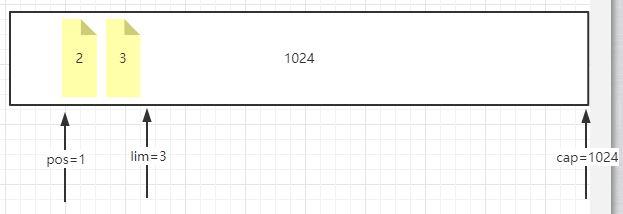Java IO学习笔记二:DirectByteBuffer与HeapByteBuffer
作者:Grey
原文地址:Java IO学习笔记二:DirectByteBuffer与HeapByteBuffer
ByteBuffer.allocate()与ByteBuffer.allocateDirect()的基本使用
这两个API封装了一个统一的ByteBuffer返回值,在使用上是无差别的。
import java.nio.ByteBuffer;
public class TestByteBuffer {
public static void main(String[] args) {
ByteBuffer buffer = ByteBuffer.allocateDirect(1024);
System.out.println("position: " + buffer.position());
System.out.println("limit: " + buffer.limit());
System.out.println("capacity: " + buffer.capacity());
System.out.println("mark: " + buffer);
buffer.put("123".getBytes());
System.out.println("-------------put:123......");
System.out.println("mark: " + buffer);
buffer.flip();
System.out.println("-------------flip......");
System.out.println("mark: " + buffer);
buffer.get();
System.out.println("-------------get......");
System.out.println("mark: " + buffer);
buffer.compact();
System.out.println("-------------compact......");
System.out.println("mark: " + buffer);
buffer.clear();
System.out.println("-------------clear......");
System.out.println("mark: " + buffer);
}
}
输出结果是:
mark: java.nio.DirectByteBuffer[pos=0 lim=1024 cap=1024]
-------------put:123......
mark: java.nio.DirectByteBuffer[pos=3 lim=1024 cap=1024]
-------------flip......
mark: java.nio.DirectByteBuffer[pos=0 lim=3 cap=1024]
-------------get......
mark: java.nio.DirectByteBuffer[pos=1 lim=3 cap=1024]
-------------compact......
mark: java.nio.DirectByteBuffer[pos=2 lim=1024 cap=1024]
-------------clear......
mark: java.nio.DirectByteBuffer[pos=0 lim=1024 cap=1024]
当分配好1024空间后,未对ByteBuffer做任何操作的时候,position最初就是0位置,limit和capcity都是1024位置,如图:

当put进去123三个字符以后:

执行flip后,pos会回到原点,lim会到目前写入的位置,这个方法主要用于读取数据:

调用get方法,拿出一个byte,如下图:

调用compact,会把前面拿掉的1个Byte位置填充:

调用clear会让整个内存回到初始分配状态:

ByteBuffer.allocate()与ByteBuffer.allocateDirect()方法的区别
可以参考:
Ron Hitches in his excellent book Java NIO seems to offer what I thought could be a good answer to your question:
Operating systems perform I/O operations on memory areas. These memory areas, as far as the operating system is concerned, are contiguous sequences of bytes. It's no surprise then that only byte buffers are eligible to participate in I/O operations. Also recall that the operating system will directly access the address space of the process, in this case the JVM process, to transfer the data. This means that memory areas that are targets of I/O perations must be contiguous sequences of bytes. In the JVM, an array of bytes may not be stored contiguously in memory, or the Garbage Collector could move it at any time. Arrays are objects in Java, and the way data is stored inside that object could vary from one JVM implementation to another.
For this reason, the notion of a direct buffer was introduced. Direct buffers are intended for interaction with channels and native I/O routines. They make a best effort to store the byte elements in a memory area that a channel can use for direct, or raw, access by using native code to tell the operating system to drain or fill the memory area directly.
Direct byte buffers are usually the best choice for I/O operations. By design, they support the most efficient I/O mechanism available to the JVM. Nondirect byte buffers can be passed to channels, but doing so may incur a performance penalty. It's usually not possible for a nondirect buffer to be the target of a native I/O operation. If you pass a nondirect ByteBuffer object to a channel for write, the channel may implicitly do the following on each call:
Create a temporary direct ByteBuffer object.
Copy the content of the nondirect buffer to the temporary buffer.
Perform the low-level I/O operation using the temporary buffer.
The temporary buffer object goes out of scope and is eventually garbage collected.
This can potentially result in buffer copying and object churn on every I/O, which are exactly the sorts of things we'd like to avoid. However, depending on the implementation, things may not be this bad. The runtime will likely cache and reuse direct buffers or perform other clever tricks to boost throughput. If you're simply creating a buffer for one-time use, the difference is not significant. On the other hand, if you will be using the buffer repeatedly in a high-performance scenario, you're better off allocating direct buffers and reusing them.
Direct buffers are optimal for I/O, but they may be more expensive to create than nondirect byte buffers. The memory used by direct buffers is allocated by calling through to native, operating system-specific code, bypassing the standard JVM heap. Setting up and tearing down direct buffers could be significantly more expensive than heap-resident buffers, depending on the host operating system and JVM implementation. The memory-storage areas of direct buffers are not subject to garbage collection because they are outside the standard JVM heap.
The performance tradeoffs of using direct versus nondirect buffers can vary widely by JVM, operating system, and code design. By allocating memory outside the heap, you may subject your application to additional forces of which the JVM is unaware. When bringing additional moving parts into play, make sure that you're achieving the desired effect. I recommend the old software maxim: first make it work, then make it fast. Don't worry too much about optimization up front; concentrate first on correctness. The JVM implementation may be able to perform buffer caching or other optimizations that will give you the performance you need without a lot of unnecessary effort on your part.
allocate分配方式产生的内存开销是在JVM中的,allocateDirect分配方式产生的开销在JVM之外,以就是系统级的内存分配。系统级别内存的分配比JVM内存的分配要耗时多。所以并非不论什么时候 allocateDirect的操作效率都是很高的。
那什么时候使用堆内存,什么时候使用直接内存?
参考:NIO ByteBuffer 的 allocate 和 allocateDirect 的区别
什么情况下使用DirectByteBuffer(ByteBuffer.allocateDirect(int))?
1、频繁的native IO,即缓冲区 中转 从操作系统获取的文件数据、或者使用缓冲区中转网络数据等
2、不需要经常创建和销毁DirectByteBuffer对象
3、经常复用DirectByteBuffer对象,即经常写入数据到DirectByteBuffer中,然后flip,再读取出来,最后clear。。反复使用该DirectByteBuffer对象。
而且,DirectByteBuffer不会占用堆内存。。也就是不会受到堆大小限制,只在DirectByteBuffer对象被回收后才会释放该缓冲区。
什么情况下使用HeapByteBuffer(ByteBuffer.allocate(int))?
1、同一个HeapByteBuffer对象很少被复用,并且该对象经常是用一次就不用了,此时可以使用HeapByteBuffer,因为创建HeapByteBuffer开销比DirectByteBuffer低。
(但是!!创建所消耗时间差距只是一倍以下的差距,一般一次只会创建一个DirectByteBuffer对象反复使用,而不会创建几百个DirectByteBuffer,
所以在创建一个对象的情况下,HeapByteBuffer并没有什么优势,所以,开发中要使用ByteBuffer时,直接用DirectByteBuffer就行了)
源码
Java IO学习笔记二:DirectByteBuffer与HeapByteBuffer的更多相关文章
- Java IO学习笔记二
Java IO学习笔记二 流的概念 在程序中所有的数据都是以流的方式进行传输或保存的,程序需要数据的时候要使用输入流读取数据,而当程序需要将一些数据保存起来的时候,就要使用输出流完成. 程序中的输入输 ...
- Java IO学习笔记:概念与原理
Java IO学习笔记:概念与原理 一.概念 Java中对文件的操作是以流的方式进行的.流是Java内存中的一组有序数据序列.Java将数据从源(文件.内存.键盘.网络)读入到内存 中,形成了 ...
- Java IO学习笔记总结
Java IO学习笔记总结 前言 前面的八篇文章详细的讲述了Java IO的操作方法,文章列表如下 基本的文件操作 字符流和字节流的操作 InputStreamReader和OutputStreamW ...
- Java IO学习笔记三
Java IO学习笔记三 在整个IO包中,实际上就是分为字节流和字符流,但是除了这两个流之外,还存在了一组字节流-字符流的转换类. OutputStreamWriter:是Writer的子类,将输出的 ...
- Java IO学习笔记一
Java IO学习笔记一 File File是文件和目录路径名的抽象表示形式,总的来说就是java创建删除文件目录的一个类库,但是作用不仅仅于此,详细见官方文档 构造函数 File(File pare ...
- Java IO学习笔记一:为什么带Buffer的比不带Buffer的快
作者:Grey 原文地址:Java IO学习笔记一:为什么带Buffer的比不带Buffer的快 Java中为什么BufferedReader,BufferedWriter要比FileReader 和 ...
- Java IO学习笔记三:MMAP与RandomAccessFile
作者:Grey 原文地址:Java IO学习笔记三:MMAP与RandomAccessFile 关于RandomAccessFile 相较于前面提到的BufferedReader/Writer和Fil ...
- Java IO学习笔记四:Socket基础
作者:Grey 原文地址:Java IO学习笔记四:Socket基础 准备两个Linux实例(安装好jdk1.8),我准备的两个实例的ip地址分别为: io1实例:192.168.205.138 io ...
- Java IO学习笔记六:NIO到多路复用
作者:Grey 原文地址:Java IO学习笔记六:NIO到多路复用 虽然NIO性能上比BIO要好,参考:Java IO学习笔记五:BIO到NIO 但是NIO也有问题,NIO服务端的示例代码中往往会包 ...
随机推荐
- JVM虚拟机-垃圾回收机制与垃圾收集器概述
目录 前言 什么是垃圾回收 垃圾回收的区域 垃圾回收机制 流程 怎么判断对象已经死亡 引用计数法 可达性分析算法 不可达的对象并非一定会回收 关于引用 强引用(StrongReference) 软引用 ...
- C++ primer plus读书笔记——第13章 类继承
第13章 类继承 1. 如果购买厂商的C库,除非厂商提供库函数的源代码,否则您将无法根据自己的需求,对函数进行扩展或修改.但如果是类库,只要其提供了类方法的头文件和编译后的代码,仍可以使用库中的类派生 ...
- C++ primer plus读书笔记——第10章 对象和类
第10章 对象和类 1. 基本类型完成了三项工作: 决定数据对象需要的内存数量: 决定如何解释内存中的位: 决定可使用数据对象执行的操作或方法. 2. 不必在类声明中使用关键字private,因为这是 ...
- 使用JSONassert进行JSON对象对比
在日常工作中,会接到用户提出一张订单,修改后需要记录每次修改的信息,然后需要查看修改前后的差异信息这样的需求.要实现这样的功能方式有很多.下面介绍下JSONassert的简单使用,也方便自己后续使 ...
- 4.启动虚拟机 设置CentOS7
启动虚拟机 CentOS设置 1.点击箭头方向即可启动我们的VMware 2.设置语言 在第一步设置完成后,我们一直等待,即可来到语言设置界面 此处我们设置[中文] 3.设置安装信息 将下面带有[感叹 ...
- 【秒懂音视频开发】23_H.264编码
本文主要介绍一种非常流行的视频编码:H.264. 计算一下:10秒钟1080p(1920x1080).30fps的YUV420P原始视频,需要占用多大的存储空间? (10 * 30) * (1920 ...
- Aliyun SSL 证书签发&安装
目录 HTTPS SSL证书 签发 和 应用 证书购买 证书申请 证书安装 参考文档 HTTPS SSL证书 签发 和 应用 - SSL证书服务(Alibaba Cloud SSL Certifica ...
- 【转载】让KVM虚机能使用音箱与麦克风(vnc及ac97)
让KVM虚机能使用音箱与麦克风(vnc及ac97) 原 tantexian 发布于 2016/02/29 16:32 字数 462 阅读 164 收藏 0 点赞 1 评论 0 为什么80%的码农都做不 ...
- rsync+inotify实现全网自动化数据备份
第1章 环境配置 实例1-1 服务器及IP主机名规划 已知 4 台服务器主机名主机对应信息见下表: 服务器说明 外网 IP(NAT) 内网 IP(NAT) 主机名 web服务器 10.0.0.7/2 ...
- stm32 向W25Q256FLASH中通过 FATFS文件系统写入数据 写多了之后出现错误,之前存储的全都找不到了
stm32 像W25Q256FLASH中通过 FATFS文件系统写入数据 写多了之后出现错误,之前存储的全都找不到了 http://firebbs.cn/thread-23490-1-1.html ...
